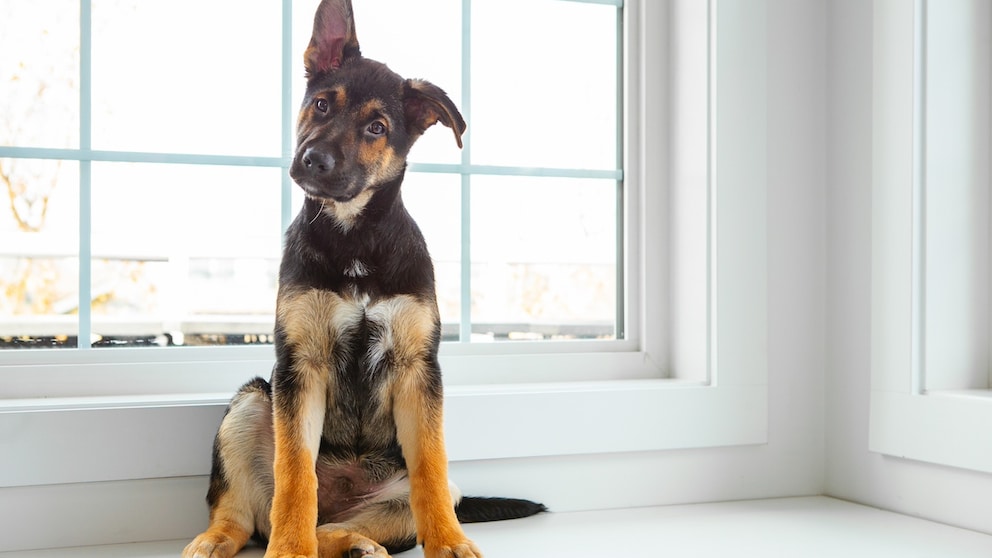March 17, 2025, 9:09 am | Read time: 5 minutes
What looks cute in puppies can be a warning sign in adult dogs: the so-called “puppy sit.” While young dogs often sit this way because their muscles are still developing, in adult dogs, it can indicate serious health problems.
In the puppy sit, the dog sits sideways on its hip. One leg is turned outwards; the other is bent. What is completely normal for puppies and looks cute should no longer occur in adult dogs. This is not a problem for puppies because their joints are still very flexible and their muscles are not yet fully developed, but it can indicate serious health problems in adult dogs. If the adult four-legged friend frequently sits in the puppy seat, owners should take this seriously and take action.
There Can Be Many Reasons Behind the Puppy Sit in Adult Dogs
“The Puppy sit in adult dogs can have many causes,” explains animal physiotherapist Sophie Sydow in an interview with PETBOOK. “It is usually a compensatory posture due to tension or even pain in the joints.”
This sitting posture, which is unusual for adult dogs, could be an indicator of muscle or joint problems such as muscle atrophy, nerve damage, or even a slipped disc.1
However, orthopedic complaints such as osteoarthritis, e.g., hip dysplasia or elbow dysplasia, patellar luxation, or malpositions are also possible. The puppy sit in adult dogs can also indicate an anal gland problem. For example, itching or pain could cause the dog to sit on its bottom.2
The Pup Sit Can Have Harmful Consequences for Dogs
In some cases, however, there are also dogs that crouch in this infantile position out of sheer convenience. Nevertheless, this should not become a habit, as puppy sitting can have harmful consequences for adult animals, as animal physiotherapist Sophie Sydow shares. “This position means that the muscles are no longer used evenly. They shorten on one side and are overstretched on the other.”
This leads to tension, whereupon the dog adopts a relaxed posture. This then results in poor posture. These could “lead to dispositions and restrictions of the joints in the long term and then also to osteoarthritis and other chronic joint diseases. This results in a whole host of other musculoskeletal disorders.” In short, this sitting position can cause problems for healthy dogs in the long term. Therefore, adult four-legged friends should no longer sit like this.
What Affected Owners Need to Know
If it does happen, owners should take a close look and observe the situation, explains Sydow. They should find out how often it happens and at what moments the dog goes into the puppy sit. It is also important to know whether the four-legged friend always sits on the left side or on the right side. Animal physiotherapists or vets need this information for diagnostic purposes.
But at what age and how often should dog owners be alarmed if their dog sits on its puppy seat? “Unfortunately, you can’t say that across the board,” explains the dog expert. It always depends on the size of the dog. “The smaller the dog, the quicker it will be fully grown. The bigger the dog, the longer it takes. Medium-sized breeds have completed their growth after one to one and a half years.” Another factor is how well-developed the muscles are, says Sydow. This also has a lot to do with how a dog sits.

On their hind legs, jumping about… How to correctly interpret the body language of rabbits

Tips & Training How to correctly train the rider’s seat and why it is important for the horse

Big differences How much sleep do dogs need?
Owners Should Be Able to Read Their Dog Well
However, dog owners may have cause for concern if their four-legged friend’s behavior suddenly changes. “If the dog has actually always sat up straight but then suddenly falls into the puppy sit more frequently or constantly. Or can’t hold the straight ‘sit’ and quickly tilts to the side or dissolves the sitting position. So he goes into ‘down’ or stands up.” However, it is also alarming if the dog cannot sit up straight at all. Other symptoms include lameness, difficulty standing up, and refusal to jump or climb stairs. Licking, scratching, and nibbling at certain parts of the body are also possible.
However, dog owners can proactively work with their dogs to prevent the dog from sitting like this in the first place. In doing so, they can practice and, if necessary, correct the proper sitting posture with the young dog. However, it is also important to provide the four-legged friend with age-appropriate exercise and to encourage and challenge it in a targeted manner. Owners should become adept at understanding their dog’s body language. “That way, you can recognize poor posture, incorrect posture, and pain at an early stage,” concludes Sophie Sydow.
But how should dogs normally sit? In a correct posture, the hind legs should be bent. They stand straight under the body, parallel to each other, knees and paws are not turned in or out, the pads of the paws touch the ground. The front paws stand vertically under the body and in front of the hind paws; elbows and paws are straight and turned neither in nor out. The back is straight and thus forms a straight line.

